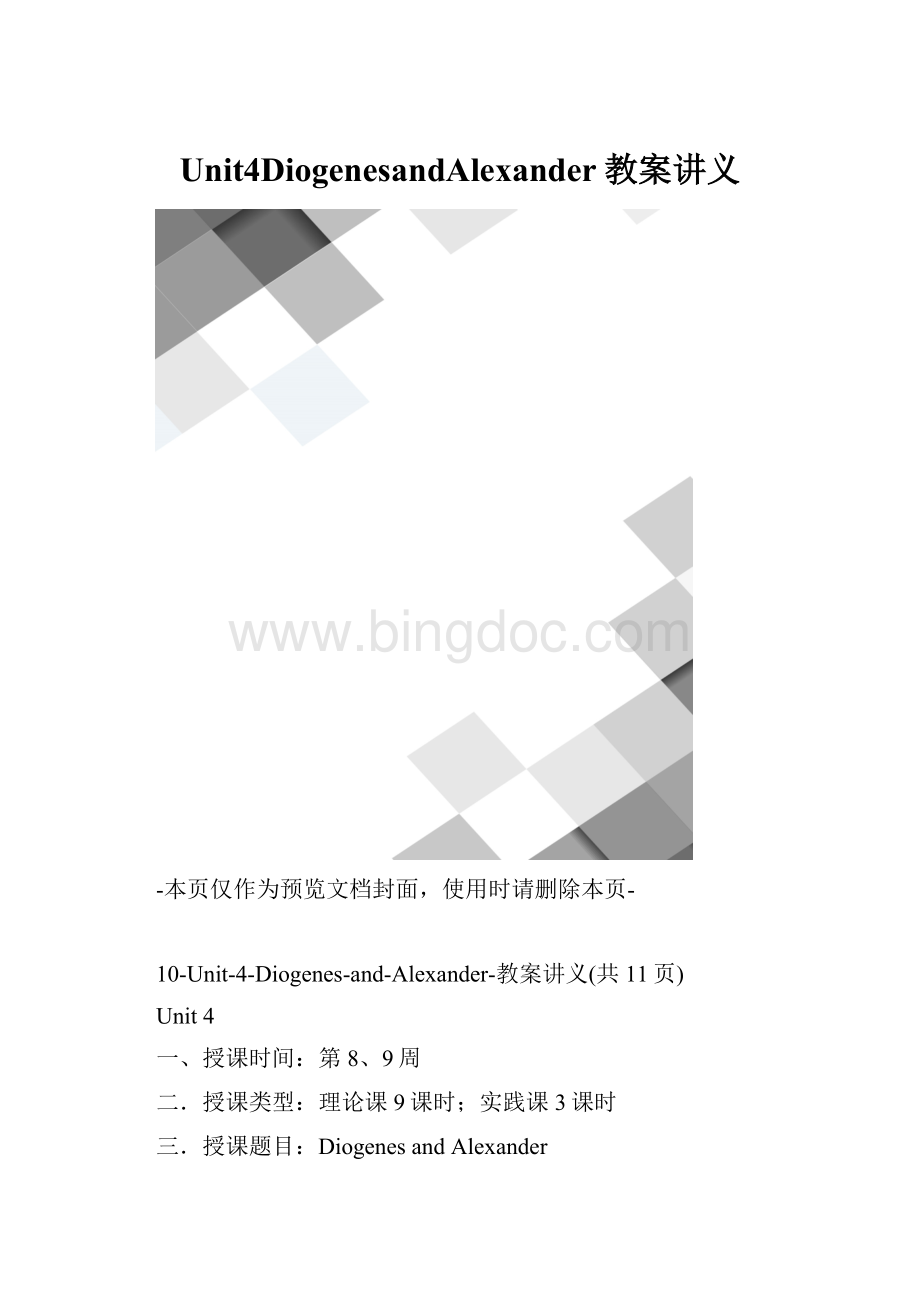Unit4DiogenesandAlexander教案讲义.docx
《Unit4DiogenesandAlexander教案讲义.docx》由会员分享,可在线阅读,更多相关《Unit4DiogenesandAlexander教案讲义.docx(18页珍藏版)》请在冰点文库上搜索。

Unit4DiogenesandAlexander教案讲义
-本页仅作为预览文档封面,使用时请删除本页-
10-Unit-4-Diogenes-and-Alexander-教案讲义(共11页)
Unit4
一、授课时间:
第8、9周
二.授课类型:
理论课9课时;实践课3课时
三.授课题目:
DiogenesandAlexander
四.授课时数:
12
五.教学目的和要求:
通过讲授课文使大学生了解有关犬儒哲学的有关知识,学会用英语解释句子以达到学以致用的目的。
要求学生主动地预习课文,课前准备练习,学会分析文章体裁和进行段落划分。
六.教学重点和难点:
1)背景知识的传授:
DiogenesandCynicism(doggishness);
2)文章的体裁分析及段落划分;
3)语言点的理解:
Wordstudy:
account;possess;form;roll;elaborate
GrammarFocus:
Thefunctionofadverbialmodifierindifferentsentences;Patterns:
thefirst/second,ect./thenext/last+to-infinitive;thefirst,ect.+who/thatclause
七.教学基本内容和纲要
PartOneWarm–up
Warm-upQuestions
Definethefollowingwordsandphrases
PartTwoBackgroundInformation
DifferencesandsimilaritiesbetweenDiogenesandAlexander
PartThreeTextAppreciation
TextAnalysis
Themeofthetext
Structureofthetext
WritingDevices
Contrast
Developingparagraphsbyexamples
Otherwaysofdevelopingparagraphs?
SentenceParaphrase
PartFourLanguageStudy
PhrasesandExpressions
Wordlist:
Phrasesandexpressionslist:
WordBuilding
Grammar
Object
PartFiveExtension
Groupdiscussion
八、教学方法和措施
本单元将运用黑板、粉笔、多媒体网络辅助教学设备等教学手段,主要采用以学生为主体、教师为主导的任务型、合作型等教学模式,具体运用教师讲授法、师生讨论、生生讨论等方法进行教学。
九.作业,讨论题,思考题
完成课后练习;
多看英语报刊杂志及英语经典小说,扩大阅读量;
精听与泛听相结合,逐步提高自己的听力水平;
积极参加英语角等有助于提高英语口语的活动;
坚持用英语写日记;
做一些专四相关练习;
十.参考资料:
1)杨立民主编,《现代大学英语精读》(3)第二版,学生用书。
北京:
外语教学与研究出版社,2012。
2)杨立民主编,《现代大学英语精读》(3)第二版,教师用书。
北京:
外语教学与研究出版社,2012。
3)李观仪主编,《新编英语教程》(第三、四册)。
上海:
上海外语教学研究出版,1999。
4)黄源深,虞苏美等主编,《综合英语教程》(1-4册)。
北京:
高等教育出版社,1998。
5)《高等学校英语专业英语教学大纲》,北京:
外语教学研究出版社,2000。
6)JudyPearsall主编,《新牛津英语词典》。
上海:
上海外语教育出版社,1998。
7)丁往道、吴冰等编著,《英语写作手册》。
北京:
外语教学与研究出版社。
8)张道真,《现代英语用法词典》(重排本)。
北京:
外语教学与研究出版社,1994。
9)张道真,温志达,《英语语法大全》上、下卷。
北京:
外语教学与研究出版社,1998。
十一、课后小结
Unit4DiogenesandAlexander
PartOneWarm–up
Warm-upQuestions
1.WhatdoestheauthortellusaboutDiogenesWhowasheWhatwashisphilosophyWhatdidhethinkwastheproblemwithpeopleHowdidheintendtohelpthemWhatwerethekeyvalueshepromotedHow,inhisopinion,couldwefindtruehappiness
2.WhatdoestheauthortellusaboutAlexanderWhatdidthiskinghaveincommonwithDiogenes,thebeggarWhywasAlexanderconsideredamanofdestiny
3.HowwouldyoucontrastthetwocharactersWhydidAlexanderdecidetovisitDiogenesWhatdidDiogenesreallymeanwhenhesaidthatAlexanderwasblockingthesunlight
Definethefollowingwordsandphrases
1.amischievouspebble
2.elaborate
3.bydesign
4.restrained
5.chivalrous
PartTwoBackgroundInformation
DifferencesandsimilaritiesbetweenDiogenesandAlexander
1.WhowasDiogenes
Abeggar
Aphilosopher
Amissionary
2.Doctrine:
Cynicism
thedoctrinethatscornedworldlyneedsandpleasuresandheldthatvirtuewasthekeytotheonlygood
3.Cynicisminmodernsense:
thebeliefofacynic,whomaintainsthatpeopleareallmotivatedbyselfishness,thatnoonewillhelpothersforgoodandsincerereasons
4.Whatarethemajortenets(principles)ofCynicismDoyoufindanyexpressionsoftheseprinciplesinthetext
self-sufficiency
shamelessness
outspokenness
perfectionofvirtue
5.Alexander
MacedonianKing:
sonofPhilip
TheThinker:
studentofAristotle
TheConqueror:
Greece,Asia,Egypt
Whydoyouthinkhewantedtobringsomanyregionsunderhisrule?
theGreatEmpire
PartThreeTextAppreciation
TextAnalysis
CharacterAnalysis
Diogenes:
thebeggar(paras.1-3)
Diogenes:
afreeman
Otherpeople:
half-men
Shelter
cask,astoragejarmadeofearthenware
ahouse(big,withmanyrooms)
Furniture
none
beds,chairs,etc.(elaborate)
Dress
blanket(half-naked)
clothes(expensive)
Food
bitsoffoodbeggedfromothers,drinkingfromhishollowedhands
elaborate
Possessions
none
horses,servants,bankaccounts(anxious)
Natureofthelife
alifebychoice,outofprinciple→natural,healthy,
independent
alifeasslavesoftheirpossessions→artificial,anxious,lossofvirtue
Therearecontrastswithinthebroadcontrast.
HowdidDiogenescontrastwithordinaryhomelesspeople?
Diogenes:
thephilosopher(para.4)
“ASocratesgonemad”:
repositioningofconventionbelownatureandreason
Threekeyprinciples:
livinginaccordwithnature
totaldisregardofconvention
independence(freedom)beingtheonlytrue,lastinggood
Diogenes:
themissionary(para.5)
Comparisonwithordinaryhermits
Similarities:
Bothgrewtiredofhumansocietywithitscomplicationsandwantedtolivesimply.
Differences:
hermits
wentawaytolivesimply—onasmallfarm,inaquietvillageoracave
Diogenes
hadasenseofmission,deliberatelychosetoliveinthebusystreetsinAthensorCorinth,inordertoconvertpeople
Whatwashismission?
“torestampthecurrency”
callpeoplebacktothenaturalwayoflife—truelife
Diogenes:
waysofteaching(para.6)
HowdidDiogenesdifferfromotherphilosophersofhistime?
Plato:
taughthisprivatepupilsinhisAcademy,whichhefoundedasoneoftheearliestcentersofadvancedlearningintheworld.
Aristotle:
taughthisownprivatepupilsbytheuseoflaboratory,instruments,andspecimens.
Diogenes:
taughtallthosewhowouldcaretolistenbyhisownexampleorbytakingpeoplearoundhimforexamples.
Hecarriedalightedlampinbroaddaylightandinspectedthefaceofeveryonehemet.
“Whenyouareallsobusy,IfeelIoughttodosomething!
”
Alexander:
citizenoftheworld(paras.11-13)
1.King:
differentfromotherMacedonians
drinking?
women?
fighting?
2.Thinker:
Aristotle’spupil,helearned
culture
philosophy
principlesofscientificresearch
3.Conqueror
tookcommandoftheLeagueofGreekStates
commander-in-chiefofanewexpeditionagainstold,rich,corruptAsia
TheDramaticEncounter(paras.14-17)
Thedifferencesandsimilaritiesbetweenthetwohistoricalcharacters.
Differences
Diogenes
Alexander
Physicalappearance
lyingonthebareearth,shoeless,bearded,half-naked,likeabeggar,adog
handsomeface,fieryglance,strongbody,purpleandgoldcloak,airofdestiny
Identification
philosopher,missionary
greatmonarch,conqueror
Status
low,treatedwithcontemptanddisapproval
high,treatedwithrespect,greetedwithabowandacclamation
Possessions&Power
none,rejectingpossessionorpower
landandabsolutepower
Mission
“restampthecurrency”:
tocallpeoplebacktothesimpleandnaturallife—truevalue
bringpeopleofthewholeworldtothelightofcivilization
Similarities
1.Bothweregreatthinkers.
2.Bothhadasenseofmission.
3.Bothwere“citizensoftheworld,”admiringtheheroicfigureofHercules,wholaboredformankind.
4.Bothwerefree.
Structureofthetext
Paras.1-10
Diogenes(life,philosophy,mission,waysofteaching)
Paras.11-13
Alexander(aphilosopherkingwithaninquiring,noblemind)
Paras.14-17
theirdramaticencounter
Relevantquestions:
1.Question:
Whatdoyouknowaboutthehistoricalbackgroundofthepeoplediscussedintheessay?
2.Question:
WhatdoestheessaytellusaboutDiogenesandAlexander?
3.Question:
Whatisapossiblereasonforanauthortotakethetimetowriteanessaylikethisdescribingpeoplewhoarelongdeadandgone?
:
Howistheessaystructured?
5.Question:
Trytofindmoreinformationaboutthesetwohistoricalfigurestosharewithyourclassmates.
6.Question:
Underlinethepartsofthetextthatyoufindparticularlywell-putandinteresting.
7.Question:
Bereadytogivecommentsontheessay.
WritingDevices
1Comparison&Contrast→examples
usetransitionalwordsorexpressionstomakecomparisonandachieveunity:
notso(para.5),theother…butfor…(para.6)
Hewasone,butnottheother.
NotsoDiogenes.(para.5)
ButforDiogenes,…
…Alexanderwasfarolderandwiserthanhisyears.(para.12)
LikeallMacedoniansheloved…(para.12)
…hewasamagnificentcommander,buthewasnotmerelyamilitaryautomaton.
OnlyDiogenes,althoughhelivedinCorinth,didnotvisitthenewmonarch.
Diogenesmerelysatup…Diogenessaidnothing.(para.14)
HeunderstoodCynicismastheotherscouldnot.(para.17)
LikeDiogenes,headmired…(para.17)
…wholaboredtohelpmankindwhileallotherstoiled…
usetransitionalparagraphtoachievecoherence
2.Parallelism
achieveincreasedstrength,soundingmorepowerful,moreeffective,.para.14
3.Euphemism
.donehisbusiness,naturalacts
4.TransferredEpithet
afigureofspeechthatcarriesthemodifieracrossandputsitontoanotherwordwhichisnotnormallymodifiedbyit,soastostresstheemotionsorfeelings
.amischievouspebble(para.1)(ItisDiogenes,notthepebble,thatismischievous.);amazedsilence(para.17)(Itisthecrowd,notthesilence,thatisamazed.)
5.Analogy
.drawingaparallelbetween“changethevalues”and“restampthecurrency”(para.5)
SentenceParaphrase
1.Sometimestheythrewbitsoffood,andgotscantthanks;sometimesamischievouspebble,andgotashowerofstonesandabuse.(para.1)
Sometimespeoplewouldthrowbitsoffoodtohim,buthehardlythankedthematall.Sometimestheywouldthrowapebbleathimforfun,butgetashowerofstonesandastreamofabuseinreturn.
2.Hislife’saimwascleartohim:
itwas“torestampthecurrency”:
totakethecleanmetalofhumanlife,toerasetheoldfalseconventionalmarkings,andtoimprintitwithitstruevalues.(para.5)
Hispurposeinlifewascleartohim:
itwas“toreprintthecoins.”Humanlifecanbetakenasthecleancoinswhichareimprintedwithfalsemarkings.Hewastoremovethefalsemarkingsandprintthetruevaluesonit.Inotherwords,hisaiminlifewastocallonpeopletorejectthefalse,conve